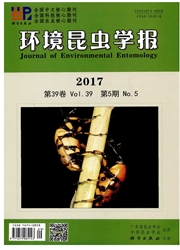

 中文摘要:
中文摘要:
赤拟谷盗和杂拟谷盗是两个同域发生的近缘储粮害虫。为明确它们的生殖隔离程度和机制,本研究比较分析了赤拟谷盗和杂拟谷盗雄虫对同种和异种雌虫的交配选择;赤拟谷盗与杂拟谷盗交配后,测定了精子在异种雌体内的存活情况;将赤拟谷盗和杂拟谷盗进行正反杂交,研究其F1代、F2代和回交代杂种是否产生及其雌雄比。结果显示,赤拟谷盗和杂拟谷盗雄虫对同种雌虫的爬跨率和交配率高于其对异种雌虫的爬跨率和交配率,表明赤拟谷盗和杂拟谷盗种间性隔离不完全;赤拟谷盗和杂拟谷盗交配后精子在异种雌体内是存活的,杂交所产的F1代卵为受精卵,说明交配后完成了精子传送和受精过程,表明种间机械隔离和配子隔离不完全;赤拟谷盗和杂拟谷盗的杂种F1代自交和回交产生了F2代和回交代,表明种间不存在杂种不育;一些杂交组合产生的F2代和回交代数量少且存在雌雄性比偏离,表明种间存在部分杂种不活和杂种衰败。本研究明确了赤拟谷盗和杂拟谷盗的生殖隔离机制,这对于揭示它们的物种进化关系有着重要意义。
 英文摘要:
英文摘要:
The red flour beetles Tribolium castaneum( Herbst) and the confused flour beetles T. confusum( Jac. du Val.) are two closely related sympatric stored-grain pests. In this study,to clarify the degree and mechanism of reproductive isolation between them,we made a comparison and analysis of behavioral responses of males T. castaneum and T. confusum to conspecific and heterospecific females. The sperm viability in heterospecific female was detected after interspecific copulation. In the laboratory,T. castaneum and T. confusum beetles were forced to hybridize in reciprocal crosses,and the number and the proportion of male and female in the F1,F2 and backcrosses hybrids were recorded. Results showed that,responses of males T. castaneum and T. confusum to conspecific females were higher than to heterospecific females,suggesting that sexual isolation between them was incomplete. The sperm in heterospecific females were live after interspecific copulation,and also the two species were able to hybridize and produce the reciprocal F1 hybrids,suggesting that mechanical isolation and gametic isolation were both incomplete. The F1 hybrids were able to cross and produce F2 hybrids and backcrosses,suggesting that hybrid sterility were not present. However,some combinations produced fewer backcrosses and F2 hybrids with a skewed sex ratio.The few offspring and skewed sex ratio might be due to the inviability of some F2 hybrids and backcrosses,and hybrid inviability and hybrid breakdown existed to a certain extent. All in all, studies on the mechanism of reproductive isolation between T. castaneum and T. confusum help to improve the understanding of their evolutionary relationships.
 同期刊论文项目
同期刊论文项目
 同项目期刊论文
同项目期刊论文
 Molecular identification of Tribolium castaneum and T. confusum(Coleoptera: Tenebrionidae) using PCR
Molecular identification of Tribolium castaneum and T. confusum(Coleoptera: Tenebrionidae) using PCR Genetic relationships between Tribolium castaneum and T. confusum based on mitochondrial DNA sequenc
Genetic relationships between Tribolium castaneum and T. confusum based on mitochondrial DNA sequenc 期刊信息
期刊信息
